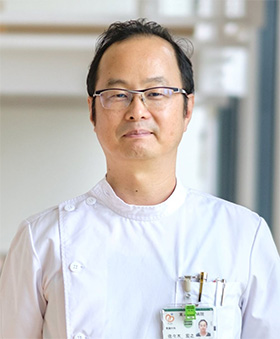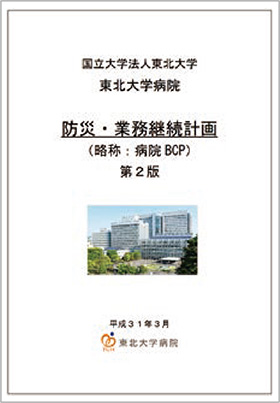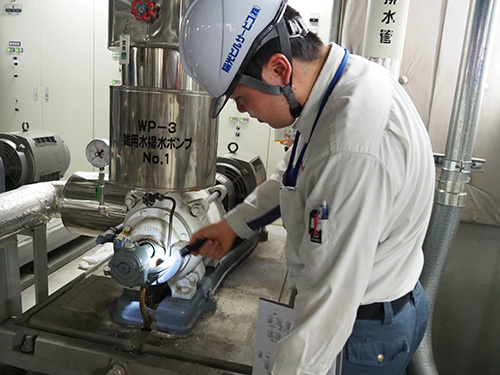2021.1.29
Exploration of Fundamental Elements of Hospital Business Continuity Plans (BCPs) Based on Lessons Learned from the Great East Japan Earthquake

Associate Professor Hiroyuki Sasaki
Disaster Medical Science Division
Business Continuity Plans (BCPs) are plans that are prepared and formulated for a given business in order to minimize damages, to keep the business’s core parts operational, and to recover quickly in case of emergencies—such as the occurrence of a disaster caused by a natural hazard. In Japan, companies have been taking the initiative in establishing BCPs since the beginning of the 21st century. However, after the 2011 Great East Japan Earthquake, hospitals also began to take serious consideration and efforts in formulating their own BCPs. Hospital BCPs are important, because hospitals are an invaluable aspect of social infrastructure that protects and sustains human life and health; it would be a major blow to society if they stop functioning in the event of a disaster.
Assoc. Prof. Hiroyuki Sasaki of IRIDeS joined a team to establish multiple Tohoku University Hospital Business Continuity Plans and has also conducted research to explore fundamental elements of hospital BCPs. At the time of the 2011 disaster, however, Sasaki was not specialized in either disaster medicine or in hospital BCPs.
In the spring of 2011, Assoc. Prof. Sasaki was working as a surgeon for regional health care in Takahagi, Ibaraki Prefecture. The situation completely changed with the megaquake. Despite the disaster, the hospital had to keep operating; even though the health care workers, including Sasaki himself, were also affected. The medical staff faced many extreme difficulties during this time.
A great amount of outside support was provided for the affected hospital. However, Sasaki realized that it was indeed difficult to receive support without causing a burden. Sasaki explains, “It was distressing for affected and stressed-out workers to deal with fully motivated and active supporters who came from outside. It was also hard to arrange how and what supports that were just brought to be incorporated in the affected hospital system. Also, supporters left in a short time. Exhausted hospital staff had to tell the same thing to newly arrived supporters over and over again.” The hospital was already in a state of extreme stress, but it was being further overloaded by well-meaning outside supporters, which could become a new disaster all on its own. Through these experiences, Sasaki began to consider how to keep operating a hospital in the face of a disaster—including better methods of sending and receiving support.
In May 2011, Sasaki was transferred to the Tohoku University Hospital. There, he immediately volunteered for positions in the field of disaster medicine. Sasaki also became a member of IRIDeS, which was established in 2012. He also obtained a license for the Disaster Medical Assistance Team (DMAT) in 2016.
When Tohoku University Hospital decided to establish its BCPs, he joined the team that would formulate it. The team first learned about the general purposes of BCPs through study meetings. They also referred to existing guidelines for BCP formulation that were provided by the Tokyo Metropolitan Government and the Ministry of Health, Labour and Welfare. Tohoku University Hospital BCP were finally established in 2017. Currently, its second edition is available online, alongside the disaster countermeasure manual [Figure]. The third edition will come out in March 2021.

Figure: Tohoku University Hospital BCP (2nd Edition)
▷What is the most important thing about BCPs?: They are not just about assembled checklists
Tohoku University Hospital BCPs have become a pioneering example among hospital BCPs in Japan. However, while working on the formulation of the BCPs, Assoc. Prof. Sasaki became aware of an issue: BCPs, in general, tended to be a collection of detailed checklists of what was necessary for business continuity.
To address this issue, Assoc. Prof. Sasaki initiated research to explore fundamental elements of hospital BCPs—observing a wide range of existing studies on hospital BCPs2). First, his research team examined research trends of hospital BCPs in both Japan and abroad. They pointed out that the number of studies on hospital BCPs has been increasing since the 2000s; especially after Hurricane Katrina, which occurred in 2005. They found that the types of disasters examined varied, reflecting different disasters occurring in different countries and regions. However, they also found that there are common trends in the discussion of hospital BCPs that transcend the differences in regions and disasters. Second, Sasaki’s research team verified the Tohoku University Hospital BCPs. Tohoku University Hospital’s BCPs contain the following three elements: “priority of operation,” “alternative methods and resources,” and “resource management.” That is, (1) identify priority of operation, (2) ensure that alternative means are available to continue essential hospital functions in the event of a disaster, and (3) manage resources to keep them functioning in the event of a disaster. Sasaki and the research team members found that these three elements correspond to arguments of the existing studies on hospital BCPs. At the end, the team argues that these three elements are indispensable for hospital BCPs in general.
▷Significance of the study
Assoc. Prof. Sasaki says, “Specific items of BCPs should change as the times and society change. Thus, operation of BCPs needs to be conducted based on understanding of the fundamental principles over those specific items.” In the study, his research team examined a wide range of hospital BCPs both in Japan and abroad, but further surveys and examinations will be necessary in order to fully clarify hospital BCPs worldwide and to establish global standards for hospital BCPs. However, Sasaki’s research team has provided important clues regarding key fundamental elements of hospital BCPs.
“The most important thing about business continuity activities is not to formulate manuals and checklists but to construct an organization and awareness that can continue managing their business continuity, including updating these documents,” Sasaki notes. “What is most important is not plans themselves, but how to build capacity to make those plans and revise them in a flexible manner.”
▷About the Future
In recent years, the Japanese Association for Disaster Medicine has begun to focus on properly receiving support amidst times of disaster and on hospital BCPs as major session themes. The lessons learned from the Great East Japan Earthquake are now widely shared and discussed. Sasaki says, “Japanese medical institutions have steadily become stronger and stronger; learning lessons from past disasters including the 1995 Great Hanshin-Awaji Earthquake, the 2011 Great East Japan Earthquake, the 2016 Kumamoto Earthquake, and the 2018 torrential rains in West Japan.” Japan is traditionally efficient at recognizing issues on the ground and then thinking and implementing practical countermeasures. Hospitals are currently facing the challenge of dealing with the new COVID-19 infection, but they have improved many of their operations within a year despite such difficult situations.
There are still issues remaining concerning hospital BCPs; one of them being the fact that many hospitals in Japan still do not have them in place. With disaster rates on the rise, more improvements will become necessary in the area of disaster medicine—including hospital BCPs. The pursuit of human longevity and better health are never-ending challenges. As both a medical professional and a researcher of disaster medicine, Assoc. Prof. Sasaki would like to continue to study and practice hospital BCPs in the context of disaster resilience.

(Photo provided by Dr. Hiroyuki Sasaki)
1)“Disaster countermeasure manual and hospital BCPs,” (in Japanese),
http://www.hosp.tohoku.ac.jp/initiative/017.html (accessed on December 30, 2020)
2) Hiroyuki Sasaki, Hiroaki Maruya, Yoshiko Abe, Motoo Fujita, Hajime Furukawa, Mikiko Fuda, Takashi Kamei, Nobuo Yaegashi, Teiji Tominaga and Shinichi Egawa (2020) “Scoping review of hospital business continuity plans to validate the improvement after the 2011 Great East Japan Earthquake and Tsunami,” The Tohoku Journal of Experimental Medicine. 251(3): 147-159. doi: 10.1620 / tjem.251.147.
For inquiries, please contact IRIDeS PR Office at +81-22-752-2049 or email: @
